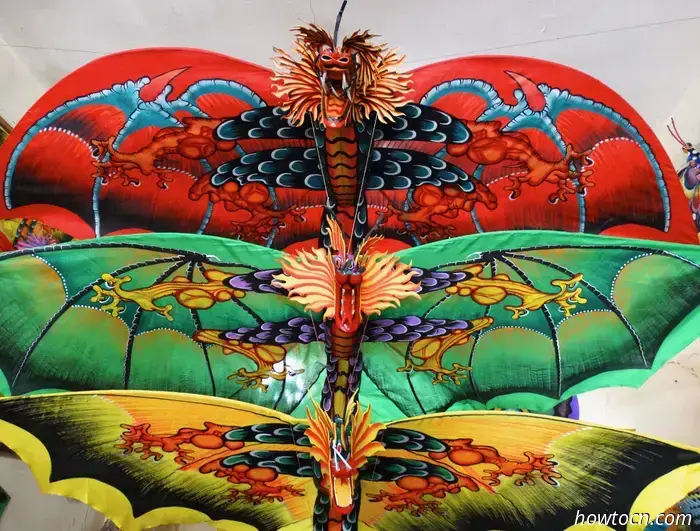
The weather over the past weekend was certainly too windy for kite flying, although spring is generally considered the perfect season for this beloved pastime. Kites have been an important aspect of Chinese culture for over 2,000 years. Initially developed during the Warring States period (475–221 BC), these flying objects were first used for military applications, such as measuring distances, testing wind conditions, and sending messages. Over time, kites transformed into symbols of good luck, celebration, and artistic creativity.
Currently, Chinese kites are recognized not only for their aesthetic beauty and craftsmanship, but also for their extensive history and cultural importance. The craft of kite-making has evolved over centuries, leading to the emergence of distinct regional styles that contribute to the rich diversity of this ancient art form.
The Four Major Schools of Chinese Kite-Making
Among the various types of Chinese kites, four styles are particularly prominent: Ha, Jin, Ma, and Cao kites. Each of these styles showcases a unique perspective on design, technique, and artistic expression.
Ha Kites
Ha kites, named after their creator, the esteemed kite master Ha Guoliang, first appeared in northern China, particularly in Hebei province. Known for their elegance and simplicity, this style utilizes lightweight materials. Ha kites often feature a minimalistic design, showcasing traditional shapes like birds, insects, and geometric forms. They are typically constructed with bamboo frames and adorned with colorful paper or fabric.
What distinguishes Ha kites is their emphasis on aerodynamic efficiency, enabling them to fly smoothly and steadily even in moderate winds. The craftsmanship is meticulous, with kite-making involving intricate knotting and a strong focus on detail. Ha kites are lauded for their delicate balance of functionality and artistry.
Jin Kites
Jin kites are named after the famous kite master Jin Fuzhong, who worked in the Forbidden City during the Qing dynasty. The last emperor, Pu Yi, still possesses three kites crafted by Jin. His style is celebrated for its bold and dramatic designs, marked by vibrant colors.
In contrast to Ha kites, which prioritize simplicity, Jin kites are characterized by their complexity, often featuring elaborate representations of animals, mythical beings, and legendary figures. Known for their grand proportions and excellent flying capabilities, Jin kites are made with robust frames and durable materials like silk and strong bamboo, allowing them to withstand strong winds. These kites are especially favored at kite festivals, where their impressive size and intricate details create a lasting impression.
Ma Kites
Ma kites were created by the kite master Ma Jin, who grew up in an environment where his father managed horses for a prince. Inspired by horses from a young age, Ma began his career as a painter, developing a unique fine-brush painting style focusing on flowers and birds, which influenced his kite designs.
The Ma-style kite-making technique accentuates fine, detailed painting and embroidery, resulting in kites that are nearly miniature art pieces. Unlike other styles that focus on flight, Ma-style kites are primarily decorative and are often regarded as "excellent decor for indoors rather than kites meant for the sky." Renowned for blending traditional Chinese painting techniques with kite-making, these kites embody both visual and cultural beauty.
Cao Kites
Cao kites represent a culturally rich tradition in Chinese kite-making, named after the famous Chinese author Cao Xueqin, known for the classic novel Dream of the Red Chamber. These kites encompass a wide range of themes that reflect the depth of Chinese culture and folklore. Celebrated for their artistic charm, scientific principles, entertainment value, and health benefits, they serve as both captivating artworks and collectible pieces.
This craft has a long-standing history, showcasing exquisite manufacturing methods alongside deep representations of traditional culture. The characteristics of the kites illustrate the unique cultural traits of Beijing, combining crafting techniques from both northern and southern regions. The diverse subject matter of Cao kites, along with their embodiment of traditional Chinese aesthetics and craftsmanship, makes them an invaluable part of Chinese heritage.
These various kite styles not only honor the remarkable craftsmanship of China but also represent the profound connection between the Chinese people and the natural world, offering insights into the nation’s history, mythology, and artistic essence. As kite festivals continue to be celebrated across China and globally, the tradition of Chinese kite-making persists, enchanting all who watch them soar high in the sky.





Kites have been an important aspect of Chinese culture for more than 2,000 years.